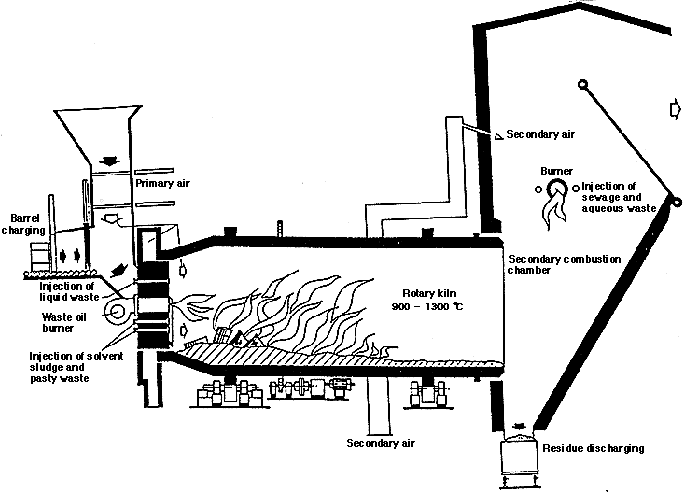Waste Treatment Technology in JAPAN
Drying, Incineration and Melting
Sumitomo Heavy Industries got a license of using technology of slagging type hazardous waste incinerator from W+E Umwelttechnik AG which is a affiliated company of ABB and has a number of delivery references 5(five) years ago. In Japan we already delivered this type of facility to Nippon Purle, Ltd., one of the affiliated companies of Nyac Corporation the largest petroleum logistics company in Japan.
Over three years this plant has been running successfully to burn out many kind of hazardous and toxic waste including barrel contained waste.
To do this sufficiently we adopt a VORTEX type secondary combustion chamber circular section shaped which make flue gas swirl by injecting secondary combustion air tangential, in this chamber flue gas is kept higher than l000 deg. C, longer than 2 seconds in retention time.
These waste is burned out and generates and emits flue gas, slag and fly ash.
Slag is vitrificated sufficiently and qualified in any regulatory leachable test to dispose safely in the landfill area. Slag is so hard that we expect to utilize as aggregates in future.
Fly ash generated at the boiler and the dust filter would contain heavy metal fractions such as lead, cadmium and so on. These polluted fly ash is specified and mixed with some immobilized agents to secure safe disposal.
[Introduction]
Sumitomo Heavy Industries CO., LTD is one of the fully integrated suppliers of hazardous waste incineration plants and associated facilities with world wide reputation for quality and reliability.
This technology is designed for large scale continuous operation. Plant capacity reaches up to 250- 300t/d per a unit and typical annual operating period exceeds 7200 hours and operation rate reached up to 90.6%.
[Process description]
The heart of the technology is a slagging rotary kiln which operates at very high temperature(l000- 1300 deg. C) to achieve complete burn out of all kinds of waste.
The flue gas resulting from incineration of waste in the kiln introduced into secondary combustion chamber, where remaining substances are thermally destroyed to meet even the most stringent regulatory requirements.
[Characteristics]
A complex automatic combustion control system can make enable to treat many kinds of hazardous waste safely which contains waste water, sludge, oil sludge, hospital waste, materials which contains heavy metals such as lead, cadmium, mercury, hexedchromium and so on, halogen organic compounds including trichloro-ethylen and PCB etc., hospital waste and steel barrel contained materials.
Flue gas is cleaned through the electro-static precipitator or the bag-house and the harm gas absorber or activate carbon filter necessarily to reduce hydrochloric gas, sulfurous acid gas and fine solid particles suspended in flue gas to meet regulatory requirements after through a boiler to save energy as steam.
